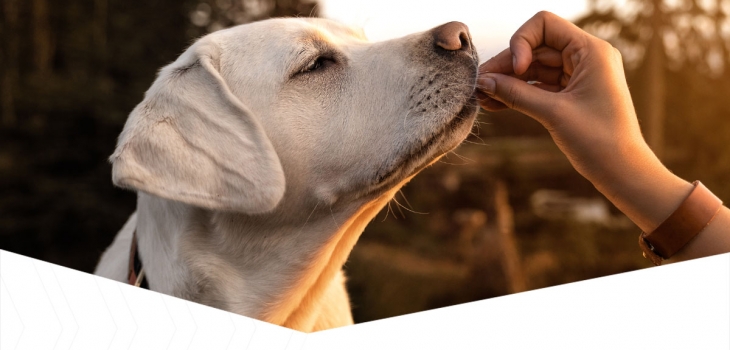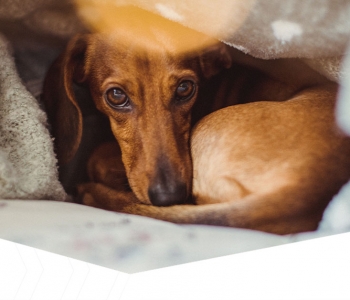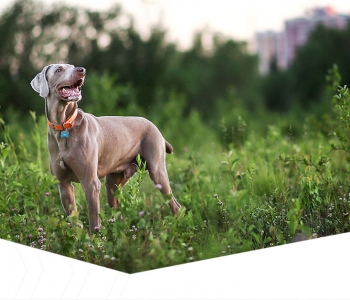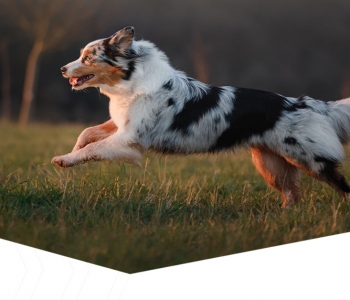
Dog Nutrition -Separating Fact From Fiction
Unravelling pet food text and sifting through marketing buzz words can be challenging. We’re here to debunk some of the biggest misconceptions about some pet food claims to help you make well informed decisions about how to best feed to your dog(s).
What does the term natural mean?
A growing number of dog owners are looking to feed natural foods because they worry about the repercussions if they don’t. As pet owners we can feel guilty about not doing the right thing. We hear the word “natural” all the time, it sounds inviting, but what does it actually mean?
According to FEDIAF, the term “natural” should be used only to describe “pet food components (derived from plant, animal, microorganism or minerals) to which nothing has been added and which have been subjected only to such physical processing as to make them suitable for pet food production”.
Natural does NOT mean that a food is organic or inherently better than a product which isn’t labelled as being natural. While it’s a great option and opens up dog owners to a wider variety of choice, it isn’t immediately the right choice based on its natural offering.
What is Dried Chicken?
Essentially this is chicken which has had its moisture, and sometimes fat removed leaving a dried or ‘meal-like’ protein source. It’s a dry, rendered, form of ground chicken, including clean flesh, skin, carcass, internal organs and/or accompanying bone. It does NOT include feathers and undeveloped eggs.
It actually looks like a powder and contains high quality muscle meat as well as smooth muscle from the intestines plus other tissues. Some suppliers and pet food manufacturers refine it removing bone and raising digestibility. By doing so this improves its quality and the ash content.
Something you may not have considered before – dried chicken is good for the environment! By incorporating the nutritious offal parts of the carcass, which would otherwise be thrown away, means less waste and so is environmentally beneficial.
What is ash?
The ash content is a legal definition which simply refers to the mineral content of the pet food. Ash is not an added ingredient; rather it’s just a really unfortunate and confusing name.
What is animal digest?
Ever wondered what the phrase “animal digest” means? This term refers to protein and or fat sources and are sometimes used to enhance flavour.
Are grains unhealthy for my pet?
There is nothing inherently bad about grains! Grains are a good source of carbohydrates, which are essential for growth in puppies and are an important source of energy for most cells of the body (young or old).
Corn and wheat, two common grains found in pet foods, are actually excellent sources of vitamins, minerals, essential fatty acids and antioxidants. When properly processed and cooked, grains are well utilised by dogs. Furthermore, the fibre provided by grains is useful for the health of the gastrointestinal tract.
Can dogs digest grain?
Yes they can. To say that can’t is a complete fallacy.
Adaptations allowing the early ancestors of modern dogs to thrive on a diet rich in starch, constituted a crucial step in the early domestication of dogs. Dogs today have the genes necessary for digesting starch/glycogen. Dogs have four to 30 copies of the gene for amylase, a protein that starts the breakdown of starch in the intestine. This is a crucial difference between carnivores and omnivores.
Are corn and wheat responsible for pet allergies?
Despite frequent claims no they’re not. On the contrary animal protein ingredients are far more allergenic to our pets than grains, and even then true food allergies (FA’s) are quite rare.
In addition FA’s are much less likely causes of skin symptoms than airborne allergies and less likely to cause gastrointestinal signs than most other causes.
Food intolerances, which don’t involve the immune system, are more common and can present as gastrointestinal signs (e.g. diarrhoea) in response to feeding foods containing certain ingredients or nutrient profiles (e.g. high fat diets) but are rarely related to grains specifically.
One of the reasons which prompted a fear of grains in pet food this was the melamine scare which affected wheat gluten and corn gluten in some pet foods back in 2007. It propagated the question of “how safe is our pet’s food?”
Another reason is the human trend which inevitably crosses over into the pet food industry, especially as pets are becoming members of the family and not just pets anymore. Many people think grain free foods are something to aspire to for themselves and so it’s pulled into the world of pet food.
It’s also important to remember that grain free food are not carbohydrate free and neither are they always lower in starch than diets containing grain.
Ultimately GRAIN is not a bad word and it’s not a filler either. Grains offer nutritional benefits- fibre, minerals, and essential amino acids.
Finally, having grain in a diet doesn’t signify poor quality. Grain free is simply an option offered to and decided by the owner. Eukanuba Nature Plus+ Grain Free with Salmon is one example of a grain free diet and may be of interest to people considering this dietary format. However, It’s always better to consider the total health benefits which a complete food provides rather than basing a decision solely on carbohydrate sources alone.
Try not to immediately dismiss grain, unless advised by your vet.
Raw diets seem to be very popular. Should I change my pet to a raw diet?
Again, there is personal choice however there is no objective evidence to suggest that raw meat diets are better than other kinds of diets for our pets.
It should always be considered that raw diets can pose pathogenic and physical risks to your pet. Raw diets can carry E. coli, Salmonella and MRSA bacteria, as well as parasites and protozoa.
Besides putting a pet at potential risk of infection, human family members are exposed and susceptible to these pathogens as well. The FDA has gone on record stating that raw diets are a public health risk plus raw and cooked bones can fracture teeth, become lodged in or tear the oesophagus or may cause intestinal tract obstructions.
If you are considering feeding raw to your dog(s) we suggest trying one of the prepared varieties which are regarded by the PFMA and the pet food industry as a whole as the responsible way to feed raw.
In closing
If you’re considering changing your dog’s food but are somewhat confused about choosing the right one for your dog’s needs then it’s important to select diets which –
- Are manufactured by reputable companies
- Own their own manufacturing facilities
- Employ full-time, qualified nutritionists
- Practice stringent quality control and
- Constantly strive to test and improve their diets.
For this information contact the companies directly. For information about Eukanuba diets simply email info@eukanuba-service.eu
Unravelling pet food text and sifting through marketing buzz words can be challenging. We’re here to debunk some of the biggest misconceptions about some pet food claims to help you make well informed decisions about how to best feed to your dog(s).
What does the term natural mean?
A growing number of dog owners are looking to feed natural foods because they worry about the repercussions if they don’t. As pet owners we can feel guilty about not doing the right thing. We hear the word “natural” all the time, it sounds inviting, but what does it actually mean?
According to FEDIAF, the term “natural” should be used only to describe “pet food components (derived from plant, animal, microorganism or minerals) to which nothing has been added and which have been subjected only to such physical processing as to make them suitable for pet food production”.
Natural does NOT mean that a food is organic or inherently better than a product which isn’t labelled as being natural. While it’s a great option and opens up dog owners to a wider variety of choice, it isn’t immediately the right choice based on its natural offering.
What is Dried Chicken?
Essentially this is chicken which has had its moisture, and sometimes fat removed leaving a dried or ‘meal-like’ protein source. It’s a dry, rendered, form of ground chicken, including clean flesh, skin, carcass, internal organs and/or accompanying bone. It does NOT include feathers and undeveloped eggs.
It actually looks like a powder and contains high quality muscle meat as well as smooth muscle from the intestines plus other tissues. Some suppliers and pet food manufacturers refine it removing bone and rasining digestibility. By doing so this improves its quality and the ash content.
Something you may not have considered before – dried chicken is good for the environment! By incorporating the nutritious offal parts of the carcass, which would otherwise be thrown away, means less waste and so is environmentally beneficial.
What is ash?
The ash content is a legal definition which simply refers to the mineral content of the pet food. Ash is not an added ingredient; rather it’s just a really unfortunate and confusing name.
What is animal digest?
Ever wondered what the phrase “animal digest” means? This term refers to protein and or fat sources and are sometimes used to enhance flavour.
Are grains unhealthy for my pet?
There is nothing inherently bad about grains! Grains are a good source of carbohydrates, which are essential for growth in puppies and are an important source of energy for most cells of the body (young or old).
Corn and wheat, two common grains found in pet foods, are actually excellent sources of vitamins, minerals, essential fatty acids and antioxidants. When properly processed and cooked, grains are well utilised by dogs. Furthermore, the fibre provided by grains is useful for the health of the gastrointestinal tract.
Can dogs digest grain?
Yes they can. To say that can’t is a complete fallacy.
Adaptations allowing the early ancestors of modern dogs to thrive on a diet rich in starch, constituted a crucial step in the early domestication of dogs. Dogs today have the genes necessary for digesting starch/glycogen. Dogs have four to 30 copies of the gene for amylase, a protein that starts the breakdown of starch in the intestine. This is a crucial difference between carnivores and omnivores.
Are corn and wheat responsible for pet allergies?
Despite frequent claims no they’re not. On the contrary animal protein ingredients are far more allergenic to our pets than grains, and even then true food allergies (FA’s) are quite rare.
In addition FA’s are much less likely causes of skin symptoms than airborne allergies and less likely to cause gastrointestinal signs than most other causes.
Food intolerances, which don’t involve the immune system, are more common and can present as gastrointestinal signs (e.g. diarrhoea) in response to feeding foods containing certain ingredients or nutrient profiles (e.g. high fat diets) but are rarely related to grains specifically.
One of the reasons which prompted a fear of grains in pet food this was the melamine scare which affected wheat gluten and corn gluten in some pet foods back in 2007. It propagated the question of “how safe is our pet’s food?”
Another reason is the human trend which inevitably crosses over into the pet food industry, especially as pets are becoming members of the family and not just pets anymore. Many people think grain free foods are something to aspire to for themselves and so it’s pulled into the world of pet food.
It’s also important to remember that grain free food are not carbohydrate free and neither are they always lower in starch than diets containing grain.
Ultimately GRAIN is not a bad word and it’s not a filler either. Grains offer nutritional benefits- fibre, minerals, and essential amino acids.
Finally, having grain in a diet doesn’t signify poor quality. Grain free is simply an option offered to and decided by the owner. Eukanuba Nature Plus+ Grain Free with Salmon is one example of a grain free diet and may be of interest to people considering this dietary format. However, It’s always better to consider the total health benefits which a complete food provides rather than basing a decision solely on carbohydrate sources alone.
Try not to immediately dismiss grain, unless advised by your vet.
Raw diets seem to be very popular. Should I change my pet to a raw diet?
Again, there is personal choice however there is no objective evidence to suggest that raw meat diets are better than other kinds of diets for our pets.
It should always be considered that raw diets can pose pathogenic and physical risks to your pet. Raw diets can carry E. coli, Salmonella and MRSA bacteria, as well as parasites and protozoa.
Besides putting a pet at potential risk of infection, human family members are exposed and susceptible to these pathogens as well. The FDA has gone on record stating that raw diets are a public health risk plus raw and cooked bones can fracture teeth, become lodged in or tear the oesophagus or may cause intestinal tract obstructions.
If you are considering feeding raw to your dog(s) we suggest trying one of the prepared varieties which are regarded by the PFMA and the pet food industry as a whole as the responsible way to feed raw.
In closing
If you’re considering changing your dog’s food but are somewhat confused about choosing the right one for your dog’s needs then it’s important to select diets which –
- Are manufactured by reputable companies
- Own their own manufacturing facilities
- Employ full-time, qualified nutritionists
- Practice stringent quality control and
- Constantly strive to test and improve their diets.
For this information contact the companies directly. For information about Eukanuba diets simply email info@eukanuba-service.eu









